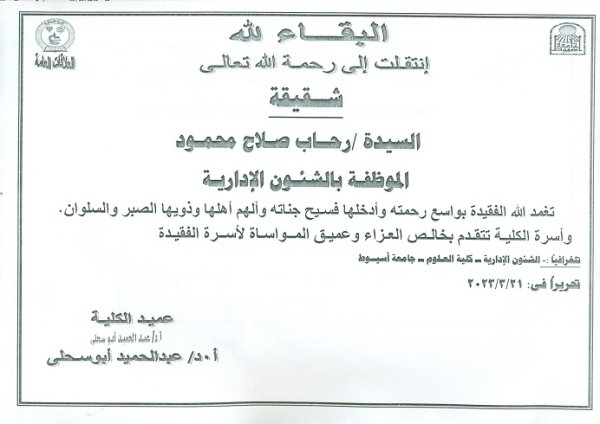Do you have any questions? (088) 2345643 - 2412000 sci_dean@aun.edu.eg
Palladium nanocrystals-embedded covalent organic framework as an efficient catalyst for Heck cross-coupling reaction
ZIF-67 and Cobalt-based@heteroatom–doped carbon nanomaterials for hydrogen production and dyes removal via adsorption and catalytic degradation
Metal-organic frameworks (MOFs) are promising catalysts for producing clean energy and environmental-based applications. This paper reported one-pot encapsulation of guest molecules, e.g., thiourea (TU) and D-Glucose-6-phosphate disodium salt dihydrate (G6P-Na2), into zeolitic imidazolate frameworks (ZIF-67), denoted as S@ZIF-67 and P@ZIF-67, respectively. The organic guest molecules offered the synthesis of cobalt-based materials (e.g., Co3O4, CoP, and CoS), embedded heteroatoms (P, N, and S) via carbonization. The materials were tested for hydrogen generation via sodium borohydride (NaBH4) hydrolysis. ZIF-67, S@ZIF-67, and P@ZIF-67 displayed maximum hydrogen generation rates (HGRmax) of 27,273, 24,000, and 60,000 mLH2 gcat−1 min−1, respectively, using 20 mg of the catalyst and 0.2 wt.% of NaBH4 at 60 °C. The materials were also investigated as potential catalysts for the adsorption and catalytic degradation of water pollutants such as organic dyes, e.g., methyl orange (MO) and Congo red (CR), with degradation efficiency of 100% and 99% in a short time (30–60 min).
Bayes Inference for the Weibull-Geometric Distribution based on Progressive Hybrid Censored Data
: The challenge of estimating the parameters of the Weibull-Geometric distribution using progressively type-I hybrid censored data is addressed in this study. For this, the maximum likelihood and Bayes methods of estimation are applied. The Bayes estimates are calculated using the Markov Chain Monte Carlo (MCMC) method. Through a Monte Carlo simulation investigation, the Bayes estimates of the parameters under two alternative loss functions are investigated and compared to their corresponding maximum likelihood estimates. For illustration, a practical set of data is used.
Apocynin abrogates methotrexate-induced nephrotoxicity: role of TLR4/NF-κB-p65/p38-MAPK, IL-6/STAT-3, PPAR-γ, and SIRT1/FOXO3 signaling pathways
The present study was designed to evaluate the potential renoprotective impacts of apocynin (APC) against nephrotoxicity induced by methotrexate (MTX) administration. To fulfill this aim, rats were allocated into four groups: control; APC (100 mg/kg/day; orally); MTX (20 mg/kg; single intraperitoneal dose at the end of the 5th day of the experiment); and APC +MTX (APC was given orally for 5 days before and 5 days after induction of renal toxicity by MTX). On the 11th day, samples were collected to estimate kidney function biomarkers, oxidative stress, pro-inflammatory cytokines, and other molecular targets. Compared to the MTX control group, treatment with APC significantly decreased urea, creatinine, and KIM-1 levels and improved kidney histological alterations. Furthermore, APC restored oxidant/antioxidant balance, as evidenced by a remarkable alleviation of MDA, GSH, SOD, and MPO levels. Additionally, the iNOS, NO, p-NF-κB-p65, Ace-NF-κB-p65, TLR4, p-p38-MAPK, p-JAK1, and p-STAT-3 expressions were reduced, while the IκBα, PPAR-γ, SIRT1, and FOXO3 expressions were significantly increased. In NRK-52E cells, MTX-induced cytotoxicity was protected by APC in a concentration-dependent manner. In addition, increased expression of p-STAT-3 and p-JAK1/2 levels were reduced in MTX-treated NRK-52E cells by APC. The in vitro experiments revealed that APC-protected MTX-mediated renal tubular epithelial cells were damaged by inhibiting the JAK/STAT3 pathway. Besides, our in vivo and in vitro results were confirmed by predicting computational pharmacology results using molecular docking and network pharmacology analysis. In conclusion, our findings proved that APC could be a good candidate for MTX-induced renal damage due to its strong antioxidative and anti-inflammatory bioactivities.
Thymoquinone ameliorates acrylamide-induced reproductive toxicity in female rats: An experimental study
Background: Acrylamide (AA) is a carcinogenic compound that causes severe
reproductive impairments and represents a high environmental risk factor.
Thymoquinone (TQ) has a unique antioxidant activity and has been widely used
as a protective agent against various types of toxicity.
Objective: To evaluate the protective effects of TQ against AA-induced reproductive
toxicity in female rats.
Materials and Methods: In this experimental study, 40 female albino rats (120-150 gr,
8-10 wk) were sorted into 4 groups, (n = 10/each), vehicle group (received a daily oral
administration of 0.5 ml saline [9%]); AA group (received a daily oral administration
with freshly prepared AA, 20 mg/kg body weight) for 21 days which is less than the
lethal dose LD50 of AA in rats (20 mg/kg body weight); AA+TQ group (received a daily
oral administration of TQ, 10 mg/kg body weight) after AA intoxication for 21 days, and
TQ group (received a daily oral administration of TQ only, 10 mg/kg body weight) for
21 consecutive days. Reproductive hormones, carcinogenic biomarkers, and oxidative
stress markers were measured. The histological assessment showed the protective
effect of TQ against AA-induced ovarian injury. Network pharmacology analysis and
molecular docking approach were carried out to determine the binding affinity of TQ
with cyclooxygenase 2.
Results: TQ administration significantly enhanced the functional capacity of the ovary
at hormones, oxidative biomarkers, and tumor markers at a significant level of p < 0.001.
Besides, TQ protects the ovary of AA-treated rats from the severe degeneration effect.
Conclusion: TQ showed a promising protective effect against AA-induced reproductive
toxicity in female rats.
Impact of Copper II Albumin Complex on Kidney Impairment Induced By Aflatoxin B1 in Rats
This study aimed to assess the renal protective efficacy of the Copper II albumin Complex (Cu-II-Album Complex) compound against aflatoxin-B1 (AFB1) in rats. Forty adult male albino rats were divided into four groups (10 rats/group): group-1 served as a negative control, the remaining groups received an oral dose of (50µg/kg) of the AFB1 daily for 3-weeks according to the following protocol: one group did not receive any treatment (group-2), while the remaining two groups received 0.05g/kg of Cu-II-Album Complex either every other day (group-3) or intoxicated with AFB1 for 3-weeks then treated daily with Cu-II-Album Complex for another 3-weeks. Serum urea and creatinine, renal histopathology, indicators of kidney repair, nuclear factor-κB (NF-κB), antioxidant gene inducer (nuclear factor erythroid-2; Nrf2), and metabolic homeostasis indicator (peroxisome proliferator-activated receptor-gamma; PPARγ) were evaluated. The Cu-II-Album Complex significantly reduced serum urea, creatinine levels, and renal NF-κB and significantly increased the renal Nrf2 and PPARγ expression. The AFB1 induced renal degenerative changes were significantly reduced in the alternative treatment with Cu-II-Album Complex. In conclusion, the Cu-II-Album Complex is an effective renal protective agent against AFB1 as indicated by maintaining the renal functions and histology and upregulating the expression of the kidney antioxidant genes and renal metabolic homeostasis indicator.
Structural, Optical, Photoluminescence and Magnetic Investigation of Doped and Co-Doped ZnO Nanoparticles
We report here the structural, optical, photoluminescence (PL), and magnetic investigation of Zn1-x-yFexMyO nanoparticles. The lattice constants and crystallite size are decreased by Fe, followed by a further decrease up to (Fe+M) = 0.30. A compressive stress is approved and the size of particle is between 180 and 277 nm and follows the sample order of ZnO, (Fe+Cu), (Fe+Ni), and Fe. Although a single value of energy gap (Eg) is found for pure and Fe-doped ZnO, two values of Eg (Egh and Egl) are found for the co-doped samples. The Eg is generally increased by Fe, followed by a further increase for the Cu-series, whereas it is decreased for the Ni-series. The refractive indices nK and nT proposed by different methods are generally decreased by Fe, followed by a further decrease for both series. Although Fe doped ZnO depressed the density of carriers (N/m*), it increased again for the co-doped samples. The residual dielectric constant ϵL is decreased by Fe, followed by an increase for the Cu-series, but it is decreased for the Ni-series. The loss factor tan δ increases slightly with Fe, followed by an increase for the Ni-series, but it decreases in the Cu-series. A significant depression of optical conductivity σopt by Fe was obtained, followed by a further decrease which is higher for the Cu-series. The PL shows four visible emissions. Interestingly, an IR emission at about 825 nm is only obtained for the co-doped samples. Furthermore, the blue emission (Iblue) was higher than UV (IUV), [(I blue/IUV) > 1], but it is greater for the Ni series than the Cu. Although ZnO exhibits diamagnetic behavior, the Fe and co-doped samples exhibit ferromagnetic with higher magnetization for the Ni-series than the Cu. The current results recommend the co-doped samples in nanoscale for some of advanced devices.
Influence of HCP/BCC interface orientation on the tribological behavior of Zr/Nb multilayer during nanoscratch: A combined experimental and atomistic study
Zr/Nb6 multilayers of 6 nm periodicity, with well-composition-modulated structures, were prepared by magnetron sputtering. Their microstructure and scratch properties were investigated using HAADF-STEM, XRD, AFM, and triboindenter. The Zr/Nb interfaces have various orientations along the growth direction. The hardness (H) and reduced elastic modulus (E) are measured as 6.6 GPa, and 176.3 GPa, respectively, resulting in a high ratio of H/E, compared to other multilayer systems such as Ta/Co and Ag/Cu, which indicates superior tribological performance. The coefficient of friction (COF) was 0.27, and the elastic recovery was observed along the scratch path. Extensive large molecular dynamics simulations (MD) were conducted to investigate the impact of different Zr/Nb interface orientations on the friction/wear behavior of Zr/Nb6 multilayers. The primary cause of plastic deformation of the Nb layer was dislocations and BCC twinning, while Zr layers deform via dislocations and intrinsic stacking faults. The Zr/Nb6 exhibited better tribological properties, such as lower COF, higher scratch hardness, and improved wear resistance compared to their single-crystal counterparts. The Pitsch-Schrader interface showed the lowest COF value, whereas Rong–Dunlop and Zhang-Killy orientations exhibited better wear resistance. The interface structure was analyzed, and its blocking strength was discussed. These findings contribute to understanding the relationship between Zr/Nb interface and wear performance and tailoring them to achieve desired properties for specific applications.



